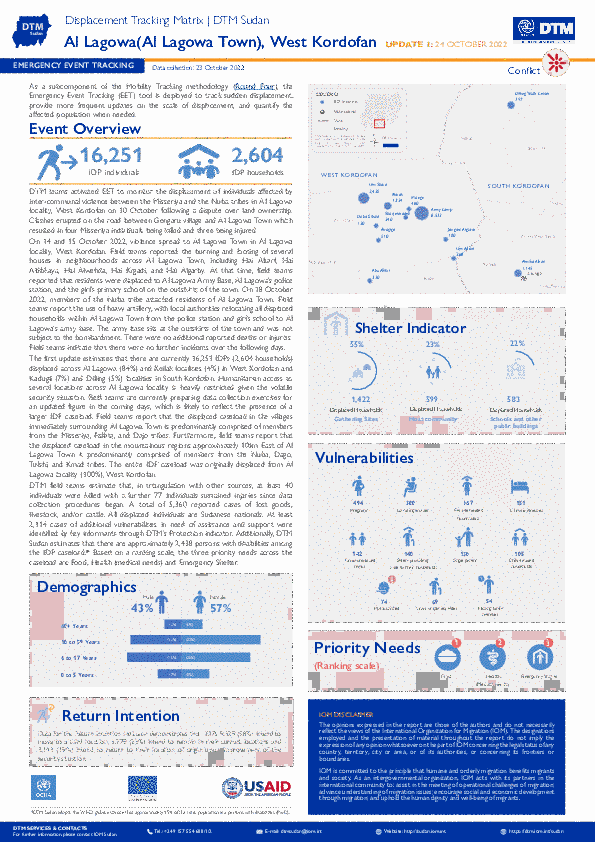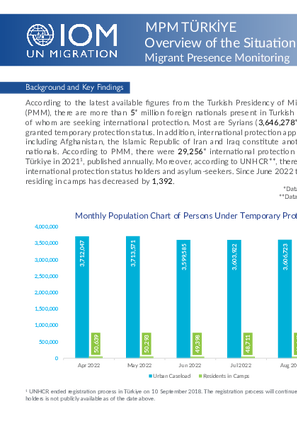-
Countries
-
Data and Analysis
-
Special Focus
-
Crisis Responses

Contact
DTM Ethiopia, SLOAddisAbabaDTM@iom.int
Language
English
Location
Ethiopia
Period Covered
Sep 01 2022
Sep 30 2022
Activity
- Flow Monitoring
In September 2022, a total of 28,983 movements were observed across five of Ethiopia's flow monitoring points (FMPs). This represents an 11% increase in daily average movements in comparison with August 2022 when an average of 871 movements per day were observed.
Outgoing movements during September have continued to be higher (82.1%) than incoming movements (17.9%). A total of 23,781 outgoing movements were observed of which 9,379 (39.4%) were heading towards Saudi Arabia, 3,590 (15.1%) were going to Djibouti, 1,774 (7.5%) were travelling towards Kenya, 1,637 (6.9%) to Somalia, 1,348 (5.7%) intended to reach the United Arab Emirates, 1,318 (5.5%) headed to Yemen, and 887 (3.7%) to Sudan while remaining movements were travelling to several Southern Africa, Middle Eastern, European and North American countries.
At the same time, 5,202 incoming movements were observed, of which 1,985 (38.2%) had originated from Sudan, while 1,684 (32.4%) came from Djibouti, 773 (14.9%) from Kenya, 484 (9.3%) movements from Somalia, 237 (4.6%) from Yemen and the remaining from United Republic of Tanzania, South Sudan, Uganda and Saudi Arabia. Almost all of these were Ethiopian nationals who were likely returning home.

Contact
DTMMozambique@iom.int
Language
English
Location
Mozambique
Period Covered
Oct 23 2022
Oct 24 2022
Activity
- Mobility Tracking
- Event Tracking
Fear of attacks, confirmed attacks by Non-State Armed Groups in Chiure district (Katapua localitiy) triggered 11,414 individual displacement movements within Chiure and from Katapua to Nampula (Namapa locality). An estimate of 385 Internally Displaced Persons (IDPs) have been identified with vulnerabilities. 99% of the recorded movements represent individuals displaced for the first time, 1% for the second time.
IOM teams observed an average of 5,707 individuals arriving at different locations within the reporting period (23 -24 October ). Movements in the region continue to be dynamic among host communities.

Contact
DTM Cameroon, DTMCameroun@iom.int
Language
French
Location
Cameroon
Period Covered
Oct 19 2022
Oct 23 2022
Activity
- Mobility Tracking
- Event Tracking
Le suivi des situations d’urgence (en anglais, Emergency Tracking Tool, ETT) est une des composantes de la Matrice de suivi des déplacements (DTM) déployée par l’Organisation Internationale pour les Migrations (OIM). Il a pour objectif de rassembler des informations sur les mouvements significatifs et soudains de populations ainsi que sur des urgences sécuritaires et climatiques. Les données ont été collectées par observation directe et par des entretiens téléphoniques, auprès de 05 informateurs clés, principalement les autorités locales, les organisations de la société civile (OSCs) et les représentants des populations dans les lieux affectés. Ce tableau de bord présente les informations sur les personnes affectées par les attaques répétées des GANE (Groupes Armées Non Etatiques) ayant provoqué plusieurs dégâts matériels.
Le 18 octobre 2022, le village de Guedjele, localité limitrophe de l'école publique de Moskota et située sur l'axe principal avec l'école privée catholique de Sodecoton et Galdala dans l’arrondissement de Koza, département du Mayo Tsanaga, région de l’Extrême-Nord du Cameroun, a été victime d’une incursion des GANE dans un espace champêtre autour de 11h. Cet incident a causé une panique au sein de la communauté et a provoqué le déplacement de plus de deux cents personnes vers deux localités voisines notamment Pambao et Walade dans le même arrondissement.

Contact
DTM Cameroon, DTMCameroun@iom.int
Language
French
Location
Cameroon
Period Covered
Oct 19 2022
Oct 22 2022
Activity
- Mobility Tracking
- Event Tracking
Le suivi des situations d’urgence (en anglais, Emergency Tracking Tool, ETT) est une des composantes de la Matrice de suivi des déplacements (DTM) déployée par l’Organisation Internationale pour les Migrations (OIM). Il a pour objectif de rassembler des informations sur les mouvements significatifs et soudains de populations ainsi que sur des urgences sécuritaires et climatiques. Les données ont été collectées par observation directe et par des entretiens téléphoniques, auprès de 09 informateurs clés, principalement les autorités locales, les organisations de la société civile (OSCs) et les représentants des populations sinistrées dans les lieux affectés. Ce tableau de bord présente les informations sur les personnes affectées par la montée des eaux du fleuve Logone ayant provoqué des inondations et plusieurs dégâts matériels.
Depuis le 18 octobre 2022 jusqu’à nos jours, la localité de Kalewa (République du Tchad) située sur les berges du fleuve Logone a été victime de la montée des eaux (inondations) qui ont a provoqué le déplacement de plusieurs centaines de personnes. Ce déplacement a contraint les populations a laissé derrière elles leurs bêtes et autres objets de valeurs vers le Cameroun notamment dans la localité Djarankoubou-Mousgoum dans l’arrondissement du Logone Birni, département du Logone et Chari, dans la région de l’Extrême-Nord du Cameroun.

Contact
DTM Mauritania, DTMMauritania@iom.int
Language
English
Location
Mauritania
Period Covered
Sep 01 2022
Sep 30 2022
Activity
- Survey
- Flow Monitoring Survey
- Flow Monitoring
La transhumance est une pratique de longue date en Mauritanie où elle a évolué au cours des dernières décennies telles que la raréfaction des ressources impliquant la redéfinition des routes empruntées par les troupeaux. Par conséquent, des conflits peuvent survenir lorsque les agriculteurs et les éleveurs transhumants. Dans le cadre du Suivi des Mouvements de Transhumance, l’OIM met en œuvre un système d’alerte qui a pour objectif de recenser les mouvements inattendus de bétail et les conflits ou catastrophes naturelles liés à l’utilisation des ressources naturelles et aux interactions entre agriculteurs et éleveurs, de comprendre les modes de résolution de conflits existants et d’informer les autorités compétentes, dans l’objectif de réduire les tensions dans les régions d’intervention. Ce tableau de bord présente les informations fournies par le biais de 21 informateurs clés, présents dans huit régions (Assaba, Brakna, Gorgol, Guidimakha, Hodh El Chargui, Hodh El Gharbi, Tagant et Trarza) pendant le mois de Septembre2022.

Contact
DTM Sudan; dtmsudan@iom.int
Language
English
Location
Sudan
Snapshot Date
Oct 23 2022
Activity
- Mobility Tracking
- Event Tracking
The DTM Emergency Event Tracking (EET) is deployed to track sudden displacement and population movements, provide more frequent updates on the scale of displacement, and quantify the affected population when needed. As a subcomponent of the new Mobility Tracking methodology in Sudan (Round Four), and activated on a need basis, EET utilises a broad network of key informants to capture best estimates of the affected population presence per location – a useful tool for humanitarian response planning and design.

Contact
DTM Turkey, DTMTurkey@iom.int
Language
English
Location
Republic of Türkiye
Period Covered
Jul 01 2022
Sep 30 2022
Activity
- Flow Monitoring
- Migrants presence
- Mobility Tracking
According to the latest available figures from the Turkish Presidency of Migration Management (PMM), there are more than 5* million foreign nationals present in Turkish territory, 3.6* million of whom are seeking international protection. Most are Syrians (3,646,278* individuals) who are granted temporary protection status. In addition, international protection applicants from countries including Afghanistan, the Islamic Republic of Iran and Iraq constitute another group of foreign nationals. According to PMM, there were 29,256* international protection applicants present in Türkiye in 20211, published annually. Moreover, according to UNHCR**, there are close to 330,000 international protection status holders and asylum-seekers. Since June 2022 the number of Syrians residing in camps has decreased by 1,392.
*Data source PMM, 29.09.2022
**Data source UNHCR, July 2021

Contact
DTM Europe, DTMMediterranean@iom.int
Language
English
Location
Hungary
Period Covered
Aug 01 2022
Sep 30 2022
Activity
- Survey
- Flow Monitoring
Since 24 February 2022, refugees from Ukraine and Third Country Nationals (TCNs) have been fleeing to neighbouring countries as a result of the war. 30,000 refugees from Ukraine and TCNs were registered in Hungary as of 18 October 2022, according to UNHCR and the Hungarian Government.
This report is based on a survey on profiles, displacement patterns and needs, launched by IOM’s Displacement Tracking Matrix (DTM). All interviews were conducted face-to-face by IOM’s DTM trained enumerators with adult refugees and TCNs crossing back to Ukraine. The analysis is based on 230 surveys collected between 01 August and 30 September 2022.
Interviews were carried out in various locations, such as Budapest (38) and Záhony – Szabolcs-Szatmár-Bereg County (192), and in various settings, including border crossing and transit points (e.g., train stations), the Help Centre (run by the Budapest Municipality and IOM), and collective accommodations.
This sample is not representative of all persons crossing back to Ukraine from Hungary, and results should only be considered as indicative.
Contact
DTM Yemen, iomyemendtm@iom.int
Location
Yemen
Activity
- Mobility Tracking
- Event Tracking
Period Covered
Oct 16 2022 -Oct 22 2022
From 1 January to 22 October 2022, IOM Yemen DTM tracked 9,185 households (HH) (55,110 Individuals) who experienced displacement at least once.
Between 16 and 22 October 2022, IOM Yemen DTM tracked 55 households (330 individuals) displaced at least once. The majority of people moved into/within the following governorates and districts:
- Marib (25 HHs) – Marib City (16 HHs), Marib (6 HHs), Harib (3 HHs) districts. Most displacements in the governorate originated from Al Hodeidah and Shabwah.
- Taiz (12 HHs) – Al Qahirah (7 HHs), Jabal Habashi (3 HHs), Al Mudhaffar (2 HHs) districts. Most displacements in the governorate originated from Taiz and Al Hodeidah.
- Shabwah (9 HHs) – Bayhan (6 HHs), Radum (3 HHs) districts. Most displacements in the governorate originated from Al Bayda and Al Hodeidah.
- Al Hodeidah (16 HHs) – Jabal Ras (5 HHs), Al Khukhah (3 HHs), Al Marawiah (3 HHs) districts.
- Taiz (13 HHs) – At Taiziyah (4 HHs), Maqbanah (4 HHs), Al Maafer (2 HHs) districts.
- Al Bayda (7 HHs) – Nati (4 HHs), Numan (2 HHs), Ash Sharyah (1 HHs) districts.
Population Groups
Survey Methodology
Unit of Analysis Or Observation
Type of Survey or Assessment
Keywords
Geographical Scope
Administrative boundaries with available data
The current dataset covers the following administrative boundaries

Contact
DTM Yemen, iomyemendtm@iom.int
Language
English
Location
Yemen
Period Covered
Oct 16 2022
Oct 22 2022
Activity
- Mobility Tracking
Dear Yemen Humanitarian Data Partners,
IOM Yemen DTM’s Rapid Displacement Tracking (RDT) tool collects data on estimated numbers of households forced to flee on a daily basis from their locations of origin or displacement, allowing for regular reporting of new displacements in terms of estimated numbers, geography, and needs. It also tracks returnees who returned to their location of origin.
From 1 January to 22 October 2022, IOM Yemen DTM tracked 9,185 households (HH) (55,110 Individuals) who experienced displacement at least once.
Between 16 and 22 October 2022, IOM Yemen DTM tracked 55 households (330 individuals) displaced at least once. The majority of people moved into/within the following governorates and districts:
- Marib (25 HHs) – Marib City (16 HHs), Marib (6 HHs), Harib (3 HHs) districts. Most displacements in the governorate originated from Al Hodeidah and Shabwah.
- Taiz (12 HHs) – Al Qahirah (7 HHs), Jabal Habashi (3 HHs), Al Mudhaffar (2 HHs) districts. Most displacements in the governorate originated from Taiz and Al Hodeidah.
- Shabwah (9 HHs) – Bayhan (6 HHs), Radum (3 HHs) districts. Most displacements in the governorate originated from Al Bayda and Al Hodeidah.
The majority of people moved from the following governorates and districts:
- Al Hodeidah (16 HHs) – Jabal Ras (5 HHs), Al Khukhah (3 HHs), Al Marawiah (3 HHs) districts.
- Taiz (13 HHs) – At Taiziyah (4 HHs), Maqbanah (4 HHs), Al Maafer (2 HHs) districts.
- Al Bayda (7 HHs) – Nati (4 HHs), Numan (2 HHs), Ash Sharyah (1 HHs) districts.